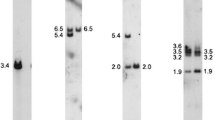Summary
-
1.
The diploid chromosome number forEquus caballus is 64, that forEquus asinus is 62, and that for the mule, 63.
-
2.
The chromosome complements ofE. caballus andE. asinus are completely different morphologically.E. caballus has 19 pairs of metacentric autosomes and 18 pairs of acrocentrics, whileE. asinus has 19 pairs of metacentric autosomes and 11 pairs of acrocentrics. The morphology of the sex chromosomes is also dissimilar between the species.
-
3.
While the disparity between parental chromosomes satisfactorily accounts for sterility in male hybrids, it does not explain the occasional fertile female able to produce several offspring with noE. asinus traits. Apparently morphological disparity between parental chromosomes is only a small part of the relatively complex matter of female gametogenesis.
Similar content being viewed by others
References
Anderson, W. S.: Fertile mare mules. J. Hered.30, 549–551 (1939).
Makino, S.: Notes on the cytological feature of male sterility in the mule. Experientia (Basel)11, 224 (1955).
-, andM. Sasaki: Personal communication 1961.
Moorhead, P. S., P. C. Nowell, W. J. Mellman, D. M. Battips, andD. A. Hungerford: Chromosome preparations of leukocytes cultured from human peripheral blood. Exp. Cell Res.20, 613–616 (1960).
Rothfels, K. H., A. A. Axelrad, L. Siminovitch, E. A. McCulloch, andR. C. Parker: The origin of altered cell lines from mouse, monkey, and man as indicated by chromosome and transplantation studies. Canad. Cancer Conf., Ed. byR. W. Begg, vol. 3, pp. 189–214. New York: Academic Press, Inc. 1959.
—, andL. Siminovitch: An air-drying technique for flattening chromosomes in mammalian cells grownin vitro. Stain Technol.33, 73–77 (1958).
Yamashina, Y.: Studies on sterility in hybrid birds. IV. Cytological researches on hybrids in the familyPhasianidae. J. Fac. Sci., Hokkaido Imp. Univ., Ser. VI, Zool.8, 307–386 (1943).
Author information
Authors and Affiliations
Additional information
This work was supported by grants from the National Science Foundation (C-17601) and from the National Cancer Institute, U. S. Public Health Service (C-5138).
The authors gratefully acknowledge the editorial assistance ofPatricia A. Ray.
Rights and permissions
About this article
Cite this article
Trujillo, J.M., Stenius, C., Christian, L.C. et al. Cromosomes of the horse, the donkey, and the mule. Chromosoma 13, 243–248 (1962). https://doi.org/10.1007/BF00577041
Received:
Issue Date:
DOI: https://doi.org/10.1007/BF00577041



